American Bonsai at the NC Arboretum
+95
kingsnake
Tom
MKBonsai
BrianS
manumidam
Chris Cochrane
Intricate Simplicity
chench53
KyleT
Maros Belan
DjTommy
Bolero
Gonetopot
Rick36
M. Frary
Van
Toshiro
fiona
Precarious
drbuzzbee
geo
LanceMac10
MichaelS
kimo
Chellis
Leo Schordje
FrankP999
dick benbow
BrianG
crust
TN Jim
Seth Ellwood
Wander
peterkang
Judgie
Kevin S - Wisco Bonsai
Vance Wood
JMcCoy
brett2013
GerhardGerber
lordy
Eric Group
my nellie
steveb
Jaybird
Todd Ellis
jgeanangel
Daygan
AlainK
Richard S
Randy_Davis
Robert J. Baran
David Brunner
William N. Valavanis
Jkd2572
Dale Cochoy
Jesse McMahon
prestontolbert
yamasuri
bingregory
Stephen Krall
DougB
Ashiod
JADunnagan
sayotefries
JudyB
Dan W.
Khaimraj Seepersad
DuncanJH
Dave Murphy
monte
MikeG
augustine
Russell Coker
Kev Bailey
lennard
BigDave
Marty Weiser
Smithy
coh
tmmason10
dorothy7774
gman
Dave Leppo
hometeamrocker
bwaynef
Billy M. Rhodes
Walter Pall
Sam Ogranaja
JimLewis
MartinSweeney
bonsaisr
Auballagh
John Quinn
Arthur Joura
99 posters
Page 2 of 40
Page 2 of 40 •  1, 2, 3 ... 21 ... 40
1, 2, 3 ... 21 ... 40 
 A Good Start
A Good Start
Graham and Dorothy - thank you for your comments!
This past weekend I collected a Chalk-bark Maple (Acer leucoderme) that has been growing in the ground for the last 9 years:
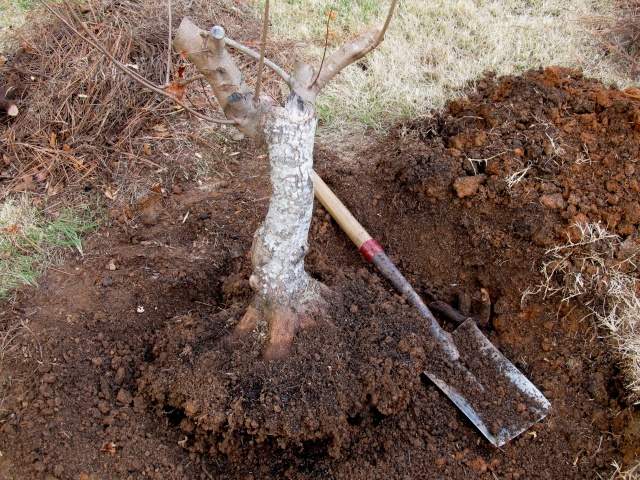
It was started from seed collected in 1992 and spent the first decade or so of its existence growing in containers, before being planted as a landscape specimen. During a heavy snowfall in 2009 a large pine limb fell on it and broke it down, and after it recovered it started looking more and more like a bonsai candidate. Last fall I pruned it back hard in anticipation of digging it up this spring.
Here it is potted up in a large grow box, where I expect it will stay for the next 3 years or more:
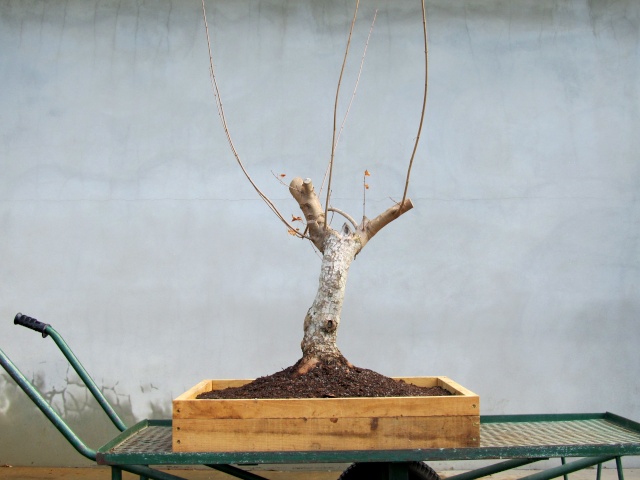

The root system was in very good condition. I have confidence it will make the transition from growing in the ground to growing in a container without too much difficulty. Here is another picture to give some idea of the size:
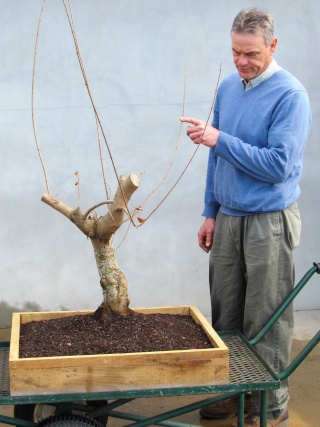
This past weekend I collected a Chalk-bark Maple (Acer leucoderme) that has been growing in the ground for the last 9 years:

It was started from seed collected in 1992 and spent the first decade or so of its existence growing in containers, before being planted as a landscape specimen. During a heavy snowfall in 2009 a large pine limb fell on it and broke it down, and after it recovered it started looking more and more like a bonsai candidate. Last fall I pruned it back hard in anticipation of digging it up this spring.
Here it is potted up in a large grow box, where I expect it will stay for the next 3 years or more:


The root system was in very good condition. I have confidence it will make the transition from growing in the ground to growing in a container without too much difficulty. Here is another picture to give some idea of the size:

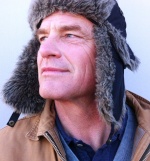
Arthur Joura- Member
 First Spring Flowers
First Spring Flowers
Who can resist the cheerful effect of forsythia blooming in the very early spring? This little planting of Minigold Forsythia (Forsythia X intermedia 'Minigold') was made about 6 years ago from individual cuttings that were left clumped together just as they were struck, an idea I first came across in one of my favorite bonsai books - "Four Seasons of Bonsai" by Kyuzo Murata. The container was made by Robert Wallace:
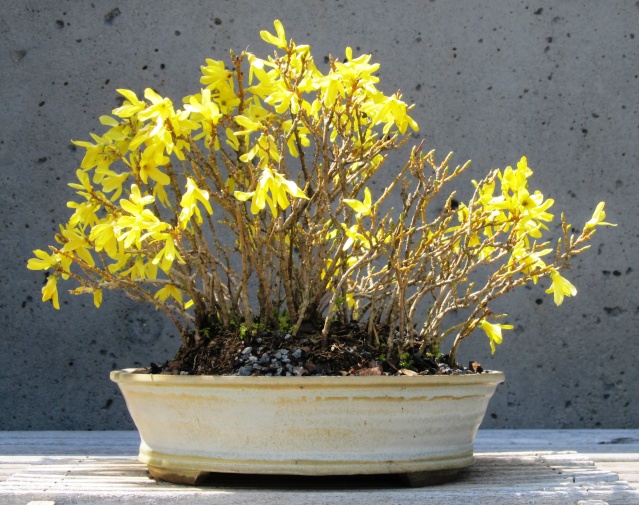


Arthur Joura- Member
 American Beech
American Beech
This is such a busy time of year! In addition to all the work to be done on the bonsai, this is also the time I do pruning on a number of larger trees in the landscape, including this American Beech:
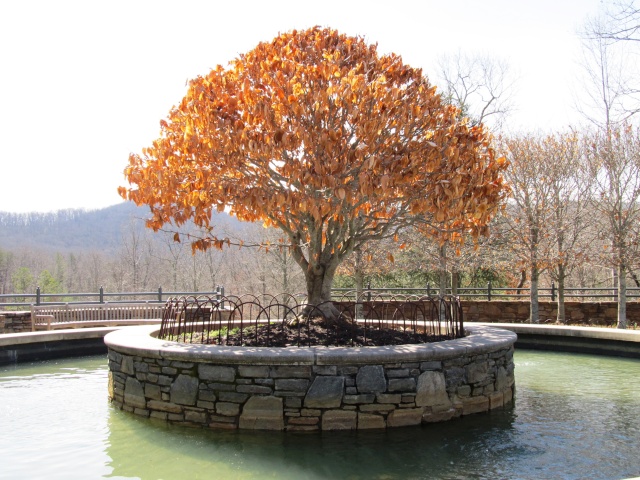
For those who are interested to know more about this specimen, I posted about it back in 2009: https://ibonsaiclub.forumotion.com/t1035-american-beech-somethingorother

For those who are interested to know more about this specimen, I posted about it back in 2009: https://ibonsaiclub.forumotion.com/t1035-american-beech-somethingorother

Arthur Joura- Member
 Southern Appalachian Spring
Southern Appalachian Spring
I am certain spring is beautiful everywhere in the temperate world, but I have a hard time imagining it is any more wonderful anywhere than it is in the mountains of Southern Appalachia.
The weather is very pleasant now in Western North Carolina, but experience says that winter can still make a return visit anytime in the next 3 or 4 weeks, and for that reason most of the display benches in the Arboretum's Bonsai Exhibition Garden remain empty. Still, the garden itself is waking up and radiating the spring feeling everywhere one looks. Here are some random images made there yesterday:
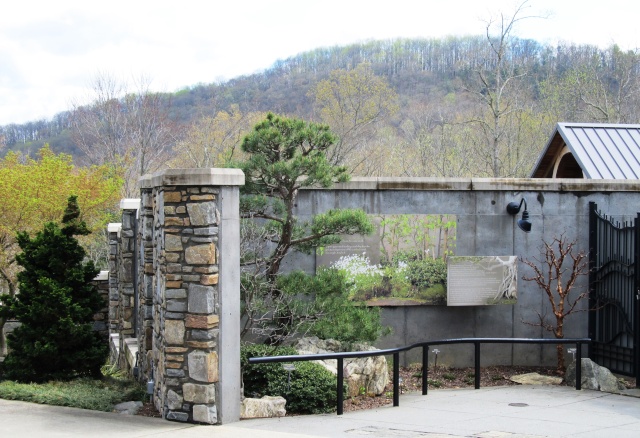
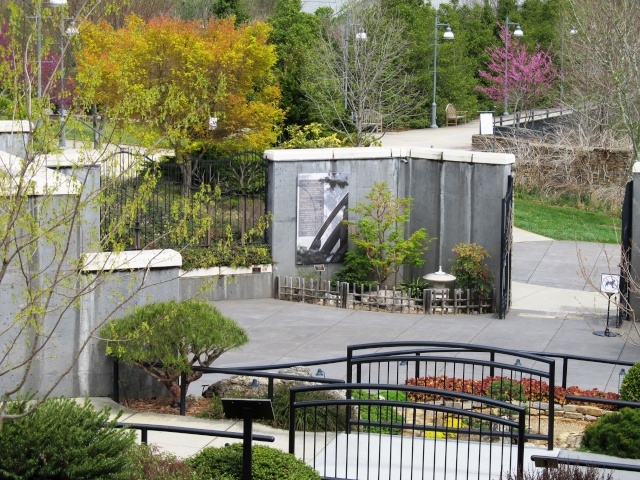
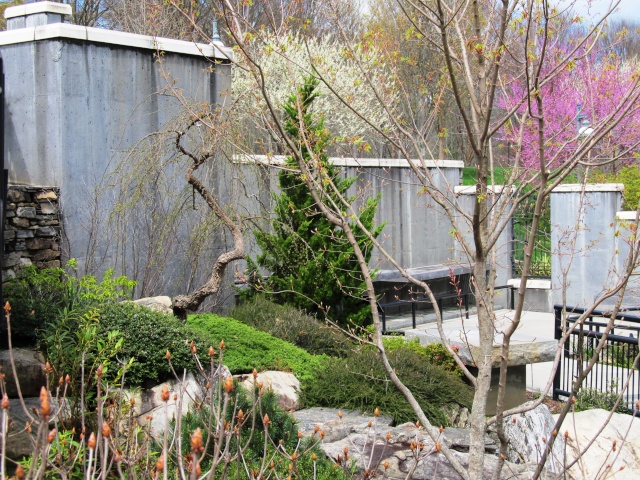

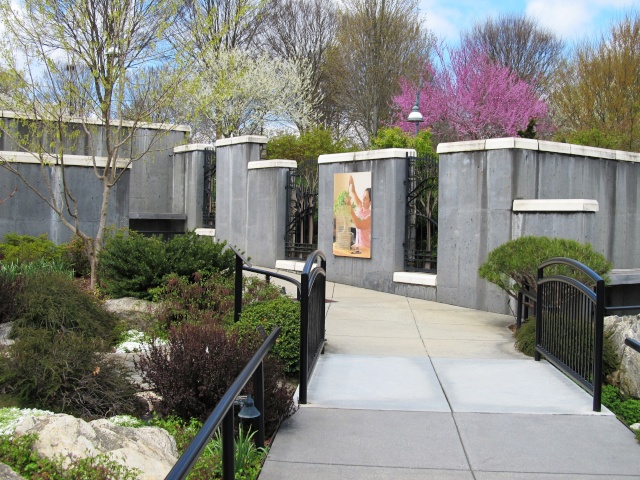
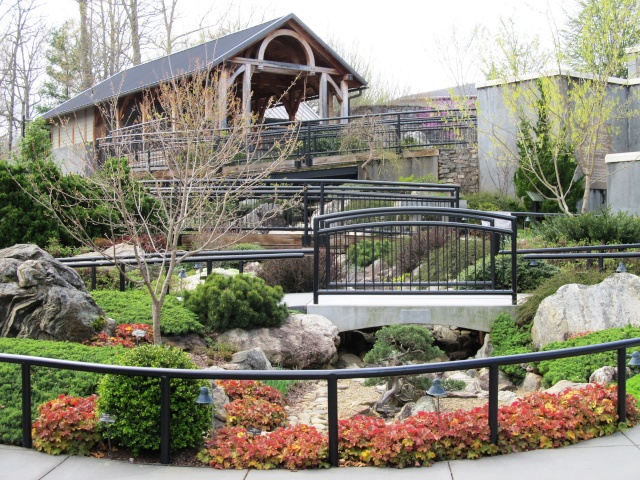
There are a few bonsai out on display, of course, because there always are:
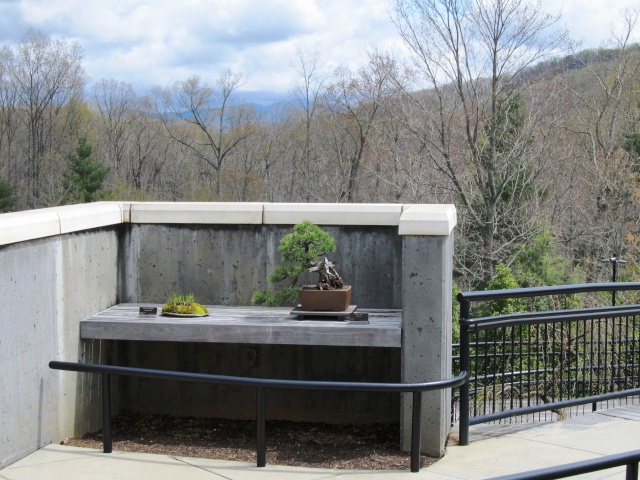
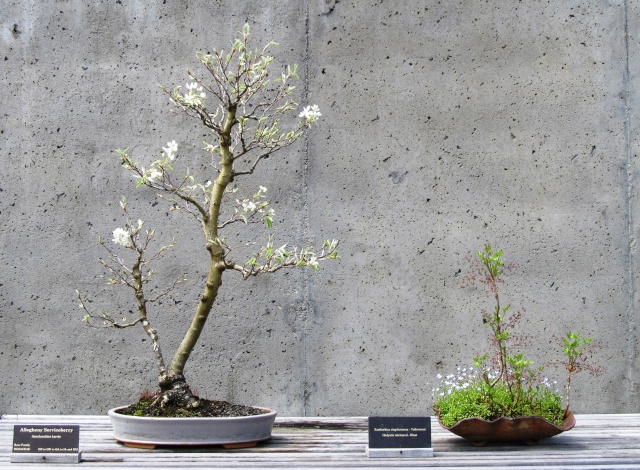
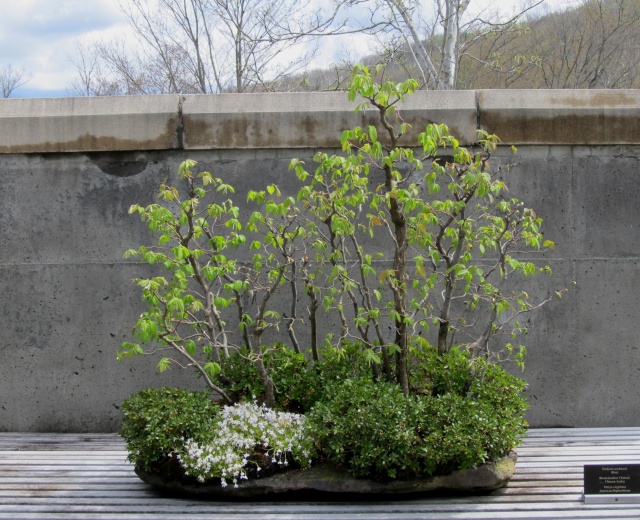
Too hectic right now to write much about any of this, but I hope you enjoy the pictures!
The weather is very pleasant now in Western North Carolina, but experience says that winter can still make a return visit anytime in the next 3 or 4 weeks, and for that reason most of the display benches in the Arboretum's Bonsai Exhibition Garden remain empty. Still, the garden itself is waking up and radiating the spring feeling everywhere one looks. Here are some random images made there yesterday:






There are a few bonsai out on display, of course, because there always are:



Too hectic right now to write much about any of this, but I hope you enjoy the pictures!

Arthur Joura- Member
 Re: American Bonsai at the NC Arboretum
Re: American Bonsai at the NC Arboretum
You have a rough job my friend. To work there every day...it must be hell. Thanks for posting these pictures. I wish I lived closer but I am very much looking forward to October. Hopefully the right weekend this time  .
.
Have a great week Arthur!!!
Sam
PS - By the way, I'm very much enjoying everything you're posting on here and hope you'll continue.
Have a great week Arthur!!!
Sam
PS - By the way, I'm very much enjoying everything you're posting on here and hope you'll continue.

Sam Ogranaja- Member
 Eastern White Pine, In Progress
Eastern White Pine, In Progress
Sam and Iris – thank you for your comments!
This is a Dwarf Eastern White Pine (Pinus strobus ‘Nana’):

I purchased this tree mail order from Forest Farm Nursery in the early 90’s, and as any of you who have ordered from them will know, they deal in very young plants. It now measures 36” in height and width. It must have been grown as a cutting because it is not a graft. I grew it in the ground for 5 years or so to build up the trunk, before transferring it to a grow box for several more years. I apologize for the vague timeline, but this tree has always been a “back burner” type project and I gave it short shrift as far as record keeping goes. The last few years I began to see it differently, and now I think it has a promising future. Today I repotted it into a high quality container made by Pennsylvania potter Ron Lang. The tree needs to be completely wired but that will not happen until next autumn, due mostly to the fact that I cannot afford to take the time to do a full wiring job until the growing season is over. The top needs further development, as well.
One aspect of this specimen I particularly enjoy is the fact that it is a cultivated form of a tree native to eastern North America, and one that many bonsai purists insist is not suitable for bonsai use, but its style is purely classical. The overall shape of the tree was laid out years ago when I was following pretty closely the classical design teachings of Yuji Yoshimura. Now my thinking about bonsai design is evolving in a decidedly more naturalistic direction. I would not approach the material the same way if I was starting out with it now, but I am content with the way this tree looks and have no intention of changing the course it is on.
This is a Dwarf Eastern White Pine (Pinus strobus ‘Nana’):

I purchased this tree mail order from Forest Farm Nursery in the early 90’s, and as any of you who have ordered from them will know, they deal in very young plants. It now measures 36” in height and width. It must have been grown as a cutting because it is not a graft. I grew it in the ground for 5 years or so to build up the trunk, before transferring it to a grow box for several more years. I apologize for the vague timeline, but this tree has always been a “back burner” type project and I gave it short shrift as far as record keeping goes. The last few years I began to see it differently, and now I think it has a promising future. Today I repotted it into a high quality container made by Pennsylvania potter Ron Lang. The tree needs to be completely wired but that will not happen until next autumn, due mostly to the fact that I cannot afford to take the time to do a full wiring job until the growing season is over. The top needs further development, as well.
One aspect of this specimen I particularly enjoy is the fact that it is a cultivated form of a tree native to eastern North America, and one that many bonsai purists insist is not suitable for bonsai use, but its style is purely classical. The overall shape of the tree was laid out years ago when I was following pretty closely the classical design teachings of Yuji Yoshimura. Now my thinking about bonsai design is evolving in a decidedly more naturalistic direction. I would not approach the material the same way if I was starting out with it now, but I am content with the way this tree looks and have no intention of changing the course it is on.

Arthur Joura- Member
 Re: American Bonsai at the NC Arboretum
Re: American Bonsai at the NC Arboretum
Thanks for having a running post going, you have some wonderful trees in your exibit!
tmmason10- Member
 More Work In Progress
More Work In Progress
Thank you Tom, for reading and posting!
Presented here for your consideration are 3 more specimens from the Arboretum’s collection. All 3 are native to the Southeastern United States and all 3 are in some stage of development prior to that where I would think of them as suitable for display.
The first is a Witch Alder (Fothergilla major ‘Mt. Airy’):

I have been growing this specimen for more than 15 years. It began as a potted nursery plant leftover from a landscape planting at the Arboretum that now looks like this:
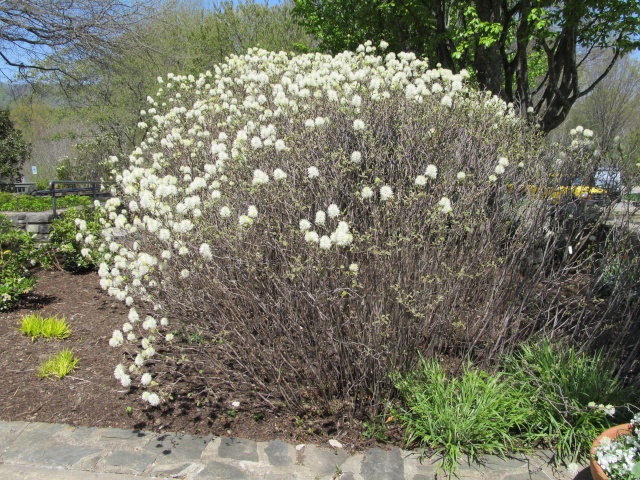
Fothergilla is such a wonderful plant in the landscape, with its bottle-brush flowers that smell like anise and its outstanding autumn color. It is also easy to grow and drought tolerant, and will prosper in both sun and shade. I have found it less wonderful for bonsai use, being very slow to develop, short of memory when wired and prone to random dieback. Still, a plant with all the botanical interest that this one offers seems worth the effort, especially right now. This specimen needs wiring, but the only time it does not is when it is wired. The container is by Sara Rayner.
The next subject is an Arrowwood Viburnum (Viburnum dentatum):
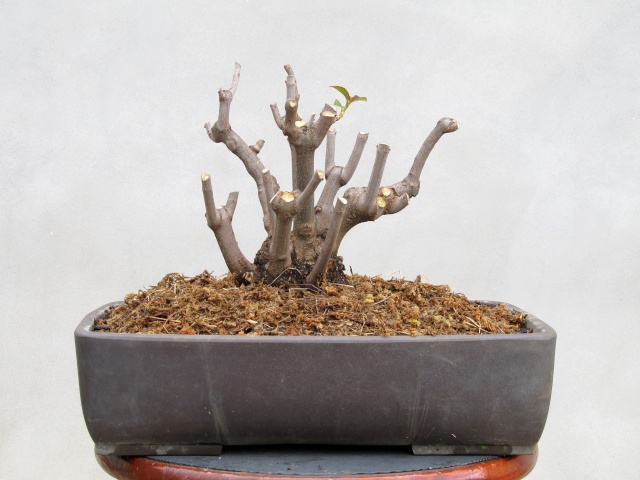

This plant has been growing in the ground for the last 4 years and began life as a volunteer that showed up in some other plant’s pot. I lifted it from the grow bed and put it in the bonsai container just earlier today. This species of viburnum is called “arrowwood” because the American Indians in the Eastern US used its branches for that purpose, due to their straightness and rigidity. This should have been a clue to me about the difficulty it would present as a bonsai candidate! I like viburnums, however, and enjoy the challenge of trying to make something out of them.
Finally, a common Red Maple (Acer rubrum):
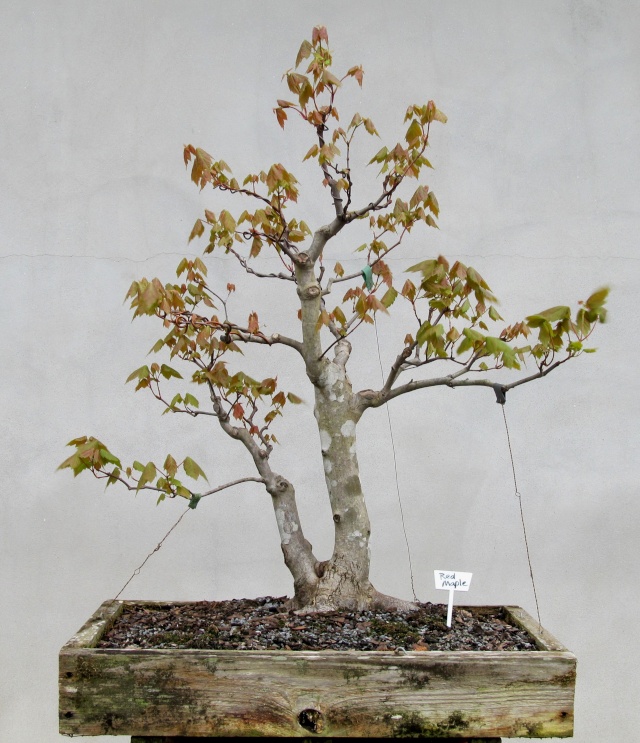
I collected this plant from the Arboretum’s property back in 2007. It was 7 or 8 feet tall, growing in a marginal woodland area that was about to be developed into a formal garden and facing imminent destruction. I sawed off most of the tree, leaving 2 stumps that have produced all the growing parts seen in the photograph. We have numerous Red Maples in various stages of development in our collection and have used them extensively in tray landscapes. I have heard and read the opinions of people who claim that Acer rubrum is inferior to other maples more commonly used for bonsai, but I do not agree. I think they are worthy subjects that will gain in popularity once more refined examples are available for bonsai growers to see. This sort of developmental and promotional work with alternative species I think of as being very much in the purview of a public collection.
Presented here for your consideration are 3 more specimens from the Arboretum’s collection. All 3 are native to the Southeastern United States and all 3 are in some stage of development prior to that where I would think of them as suitable for display.
The first is a Witch Alder (Fothergilla major ‘Mt. Airy’):

I have been growing this specimen for more than 15 years. It began as a potted nursery plant leftover from a landscape planting at the Arboretum that now looks like this:

Fothergilla is such a wonderful plant in the landscape, with its bottle-brush flowers that smell like anise and its outstanding autumn color. It is also easy to grow and drought tolerant, and will prosper in both sun and shade. I have found it less wonderful for bonsai use, being very slow to develop, short of memory when wired and prone to random dieback. Still, a plant with all the botanical interest that this one offers seems worth the effort, especially right now. This specimen needs wiring, but the only time it does not is when it is wired. The container is by Sara Rayner.
The next subject is an Arrowwood Viburnum (Viburnum dentatum):


This plant has been growing in the ground for the last 4 years and began life as a volunteer that showed up in some other plant’s pot. I lifted it from the grow bed and put it in the bonsai container just earlier today. This species of viburnum is called “arrowwood” because the American Indians in the Eastern US used its branches for that purpose, due to their straightness and rigidity. This should have been a clue to me about the difficulty it would present as a bonsai candidate! I like viburnums, however, and enjoy the challenge of trying to make something out of them.
Finally, a common Red Maple (Acer rubrum):

I collected this plant from the Arboretum’s property back in 2007. It was 7 or 8 feet tall, growing in a marginal woodland area that was about to be developed into a formal garden and facing imminent destruction. I sawed off most of the tree, leaving 2 stumps that have produced all the growing parts seen in the photograph. We have numerous Red Maples in various stages of development in our collection and have used them extensively in tray landscapes. I have heard and read the opinions of people who claim that Acer rubrum is inferior to other maples more commonly used for bonsai, but I do not agree. I think they are worthy subjects that will gain in popularity once more refined examples are available for bonsai growers to see. This sort of developmental and promotional work with alternative species I think of as being very much in the purview of a public collection.

Arthur Joura- Member
 Re: American Bonsai at the NC Arboretum
Re: American Bonsai at the NC Arboretum
I am (we all are) enjoying your updates here, Arthur. Please keep them coming.
FYI, I had a nice small arrowwood bonsai down in North Florida, but I didn't bring it up here when we moved. I think they're one of the better Viburnum for bonsai. I'll be interested in how this one develops.
FYI, I had a nice small arrowwood bonsai down in North Florida, but I didn't bring it up here when we moved. I think they're one of the better Viburnum for bonsai. I'll be interested in how this one develops.

JimLewis- Member
 Re: American Bonsai at the NC Arboretum
Re: American Bonsai at the NC Arboretum
Great thread! Thanks for taking the time to post the wonderful photos and descriptions.
I've never been to the arboretum but I've seen your trees at the National Exhibitions in Rochester. I remember being mesmerized by your beautiful display in 2010...the eastern red cedar that won the "Finest Creative Western Formal Display" award. Can you post a photo of that display if you have one? It was a stunning combination.
Also glad to see the emphasis on native plant material. The white pine looks terrific; I hope you'll post a photo after it is wired later in the year. And fothergilla...I actually bought one of these last fall thinking about developing it as a bonsai. We have some in our garden, the flowers are a treat but the fall color is even better I think.
Thanks again for starting (and maintaining) this thread!
Chris
I've never been to the arboretum but I've seen your trees at the National Exhibitions in Rochester. I remember being mesmerized by your beautiful display in 2010...the eastern red cedar that won the "Finest Creative Western Formal Display" award. Can you post a photo of that display if you have one? It was a stunning combination.
Also glad to see the emphasis on native plant material. The white pine looks terrific; I hope you'll post a photo after it is wired later in the year. And fothergilla...I actually bought one of these last fall thinking about developing it as a bonsai. We have some in our garden, the flowers are a treat but the fall color is even better I think.
Thanks again for starting (and maintaining) this thread!
Chris

coh- Member
 Re: American Bonsai at the NC Arboretum
Re: American Bonsai at the NC Arboretum
Last edited by Arthur Joura on Mon May 06, 2013 5:51 pm; edited 1 time in total

Arthur Joura- Member
 After 20 Years
After 20 Years
A few nights ago I was visited by my old friend and mentor, Dr. John L. Creech. This might have been a disturbing occurrence given that he died several years ago, but Dr. Creech came to me in a dream and he was in good spirits, smiling and with that twinkle in his eye that always made me wonder what kind of mischief he might be up to. It was great to see him again. I do not remember what went on in the dream, but I am fairly certain Dr. Creech's purpose in dropping by was to remind me of something that happened 20 years ago in the month of April, an experience he arranged for me that had a profoundly positive effect on my life.
For those who do not know of him, Dr. John Creech was a decorated veteran of World War II, a world famous plant explorer who traveled extensively in China and Japan, and the Director of the US National Arboretum from 1970 to 1980. His travels in Japan had introduced him to many bonsai professionals there, and those contacts, and particularly his friendship with Saburo Kato, were later instrumental in Dr. Creech's orchestration of the 1976 donation of 53 bonsai from the Nippon Bonsai Association to the the people of the United States in honor of our country's bicentennial year. Those trees were the beginning of what we now know as the US National Bonsai and Penjing Museum, the finest bonsai collection in the United States and one of the premier public bonsai collections in the world.
When Dr. Creech retired he relocated to Western North Carolina and immediately became involved with the NC Arboretum, which was at that point nothing more than some big plans and a small trailer parked in the forest. He agreed to be the Interim Director, lending his name and prestige to the fledgling institution while a nationwide search was conducted for the person who would become the first full time Executive Director. Once George Briggs was hired for that job, Dr. Creech stepped down from his honorary position and then offered his services as a member of the Board of Directors and a volunteer in the greenhouse. He was a volunteer when I first met him a few years later and I had no idea who he was, which allowed us to strike up a lively relationship full of good humor and wide ranging casual conversation. Once I learned of his status in the horticultural world I was never again able to be so informal around him, although he continued to be the same good natured, unassuming friend to me he always had been.
When a donation of bonsai was proposed to the NC Arboretum in 1992, Dr. Creech pushed for its acceptance. When the Arboretum ultimately decided to accept the donation and become involved with bonsai and Director Briggs looked among the staff for someone to take on this new responsibility, Dr. Creech advocated for the job to be given to me. When it ultimately was, and I was faced with the daunting prospect of measuring up to this new responsibility without having even the faintest clue of how to take care of a bonsai tree, let alone a collection of them, it was Dr. Creech who arranged my first formal bonsai education. "Don't worry" he told me, "I have some friends in Washington DC who can help..."
Back when Dr. Creech negotiated the donation of bonsai from Japan to the US, he was faced with the decision of how the priceless gift was to be managed and who was to be responsible for it. As you can imagine, there was a great deal of excitement in the American bonsai community at the prospect of these venerable trees coming to our country and Dr. Creech was deluged with suggestions as to how they should be handled. There were several big name bonsai authorities in the country who each felt they naturally were the most qualified to be named curator. There were influential bonsai organizations in the area who felt their members should of course have a hand in maintaining the collection. Dr. Creech horrified many of these people, and shocked the rest, by selecting someone from the ranks of the National Arboretum staff to be curator and announcing that the collection would be managed in-house. To make matters worse, the person selected to be curator had no prior bonsai experience; he was nothing more than a common horticulturist. Predictions of gloom and doom swiftly followed.
The man chosen by Dr. Creech to handle the awesome responsibility for the bonsai collection from Japan was Bob Drechsler. Bob was already an expert plantsman, and he applied himself to this new challenge with humility, dedication and a peerless work ethic. He meticulously studied the trees and kept detailed records of each of them throughout his tenure. He went to Japan to further his bonsai knowledge, studying with top experts from the Nippon Bonsai Association, and in America sought counsel from people like Yuji Yoshimura, John Naka and Chase Rosade. He learned on the job and quietly went about making himself an accomplished bonsai authority. Far from the disaster that was predicted, Bob Drechsler proved to be the perfect person for the task and the trees prospered under his care. When a contingent of the original donors from Japan came to the National Arboretum for the 10-year anniversary of the bicentennial gift, they announced that the bonsai they had given were better than they were at the time of their donation. When additions were made to the collection, a large donation of Penjing from China and many great works from the leading bonsai artists in North America, Bob took them into the fold, learned how to care for them and never missed a beat. His 20-year career as curator was marked by integrity, competence, dependability and success. Many, many people contributed significantly to the development of the National Bonsai and Penjing Museum, but for 20 years Bob Drechsler was the one great constant in the unfolding narrative, the steady hand on the tiller that kept the ship on course. I should add that Bob himself would scoff at all this I am writing about him. Among his other attributes, he is also one of the most self-effacing people I have ever met.
I think Bob was always conscious of the faith Dr. Creech had shown in him when he selected him to be curator, and did everything in his power to live up to it. And I know that Dr. Creech was always proud of the way Bob Drechsler stepped up to the challenge and handled the responsibility with impeccable professionalism.
In April of 1993 Dr. Creech made a few telephone calls. He arranged for me to go to the US National Arboretum and study bonsai at the National Bonsai and Penjing Museum with Bob Drechsler. He asked his old friend Skip March, chief horticulturist at the National Arboretum, if he would mind having me as a house guest. I do not think very many people ever said "no" to Dr. Creech. He was so well liked and so respected, that people would go out of their way to make things happen if he asked them to help. When I went to Washington DC that April I was a complete unknown, yet everyone I met there, upon hearing I was in Dr. Creech's good graces, treated me as if I was an honored guest of the first order. For me, knowing these people were Dr. Creech's friends made me want to do everything I could to have them think well of him for sending me.
I went to the National Bonsai and Penjing Museum as someone who was not even certain that bonsai was a worthwhile pursuit. Care for a neglected collection of strange and stunted plants had been thrust upon me and I was having a hard time convincing myself that there was any real promise in the prospect, but I was young and hungry and searching for some kind of purpose. Back home I had left behind my wife with our 2 sons, one whom was 3 years old and the other 3 months... it was way past time for me to have some idea of what I was going to do with my life. There in Washington DC I saw for the first time what bonsai were supposed to look like. These were not the straggly, abused looking plants we had in our collection, but beautiful, healthy, living works of horticultural art. And the people who took care of these great treasures, Bob Drechsler and his assistant Dan Chiplis, treated me as if I was a colleague, a peer, and they patiently explained basic information to me and helped me understand the fundamentals of developing and maintaining a bonsai collection. They most certainly understood how much I did not know at that point, and they knew when they looked at the photographs I brought of the trees I was taking care of that I was so far behind the curve the chances of my ever catching up were laughable, but they did not laugh. They encouraged. They told me I could do it and made me believe it was so.
Everyone I met there - Bob and Dan, Skip March and his wife Marlese, Janet Lanman and all the other volunteers at the Museum, went out of their way to be kind and positive and encouraging. Out of this nurturing experience a vast horizon opened up to me. By the time I left Washington I had a new idea about bonsai and a new vision of what bonsai could be at the NC Arboretum.
I had conversations with Bob Drechsler back then in which he gave me advice regarding situations I would encounter as the curator of a public collection. Some of these things I did not fully comprehend at the time, but over the last 20 years again and again Bob's words of wisdom have come back to me and helped guide my thinking. For example - when he repeatedly referred to the bonsai in the NC Arboretum's collection as "your trees", and I corrected him by pointing out that the trees belonged to the Arboretum and not to me personally, Bob smiled and told me this: "Of course the bonsai belong to the Arboretum, but until the day comes when you walk out the door for the last time they are your trees. You have to think of them that way." That is exactly how I have come to think of them. Bob also explained to me the reason he kept no bonsai of his own. He felt it was of primary importance to maintain a distinct line of separation between his professional life and his personal life, so he would never be tempted to the ethical pitfalls of blending the two. This made such clear sense to me that I have followed his example. There are not so many people in this country who curate, or have curated, public bonsai collections, and this line of work is a completely different entity than being a bonsai professional for hire or having a personal collection, no matter how superior that collection might be. It was my great good fortune to have the opportunity to learn from the man who set the standard for people in my profession.
When I think back on that time in Washington 20 years ago, the memory is golden to me, an experience that changed my life. I will never forget it, or the people who made it possible. This piece of writing is of such a length that I suspect few people will read it in its entirety, but it could easily have been 2 or 3 times as long. April is such a demanding time of year for me that this account had to be written in bits and pieces, late at night during hours stolen from sleep, and so it was not possible to capture every thought I would have liked to convey. In the end, perhaps none of this will be of much interest to others anyway. But I had to do it - I would not want to be feeling sheepish next time Dr. Creech comes to pay me a visit.
For those who do not know of him, Dr. John Creech was a decorated veteran of World War II, a world famous plant explorer who traveled extensively in China and Japan, and the Director of the US National Arboretum from 1970 to 1980. His travels in Japan had introduced him to many bonsai professionals there, and those contacts, and particularly his friendship with Saburo Kato, were later instrumental in Dr. Creech's orchestration of the 1976 donation of 53 bonsai from the Nippon Bonsai Association to the the people of the United States in honor of our country's bicentennial year. Those trees were the beginning of what we now know as the US National Bonsai and Penjing Museum, the finest bonsai collection in the United States and one of the premier public bonsai collections in the world.
When Dr. Creech retired he relocated to Western North Carolina and immediately became involved with the NC Arboretum, which was at that point nothing more than some big plans and a small trailer parked in the forest. He agreed to be the Interim Director, lending his name and prestige to the fledgling institution while a nationwide search was conducted for the person who would become the first full time Executive Director. Once George Briggs was hired for that job, Dr. Creech stepped down from his honorary position and then offered his services as a member of the Board of Directors and a volunteer in the greenhouse. He was a volunteer when I first met him a few years later and I had no idea who he was, which allowed us to strike up a lively relationship full of good humor and wide ranging casual conversation. Once I learned of his status in the horticultural world I was never again able to be so informal around him, although he continued to be the same good natured, unassuming friend to me he always had been.
When a donation of bonsai was proposed to the NC Arboretum in 1992, Dr. Creech pushed for its acceptance. When the Arboretum ultimately decided to accept the donation and become involved with bonsai and Director Briggs looked among the staff for someone to take on this new responsibility, Dr. Creech advocated for the job to be given to me. When it ultimately was, and I was faced with the daunting prospect of measuring up to this new responsibility without having even the faintest clue of how to take care of a bonsai tree, let alone a collection of them, it was Dr. Creech who arranged my first formal bonsai education. "Don't worry" he told me, "I have some friends in Washington DC who can help..."
* * * * * * * * * * * * * *
Back when Dr. Creech negotiated the donation of bonsai from Japan to the US, he was faced with the decision of how the priceless gift was to be managed and who was to be responsible for it. As you can imagine, there was a great deal of excitement in the American bonsai community at the prospect of these venerable trees coming to our country and Dr. Creech was deluged with suggestions as to how they should be handled. There were several big name bonsai authorities in the country who each felt they naturally were the most qualified to be named curator. There were influential bonsai organizations in the area who felt their members should of course have a hand in maintaining the collection. Dr. Creech horrified many of these people, and shocked the rest, by selecting someone from the ranks of the National Arboretum staff to be curator and announcing that the collection would be managed in-house. To make matters worse, the person selected to be curator had no prior bonsai experience; he was nothing more than a common horticulturist. Predictions of gloom and doom swiftly followed.
The man chosen by Dr. Creech to handle the awesome responsibility for the bonsai collection from Japan was Bob Drechsler. Bob was already an expert plantsman, and he applied himself to this new challenge with humility, dedication and a peerless work ethic. He meticulously studied the trees and kept detailed records of each of them throughout his tenure. He went to Japan to further his bonsai knowledge, studying with top experts from the Nippon Bonsai Association, and in America sought counsel from people like Yuji Yoshimura, John Naka and Chase Rosade. He learned on the job and quietly went about making himself an accomplished bonsai authority. Far from the disaster that was predicted, Bob Drechsler proved to be the perfect person for the task and the trees prospered under his care. When a contingent of the original donors from Japan came to the National Arboretum for the 10-year anniversary of the bicentennial gift, they announced that the bonsai they had given were better than they were at the time of their donation. When additions were made to the collection, a large donation of Penjing from China and many great works from the leading bonsai artists in North America, Bob took them into the fold, learned how to care for them and never missed a beat. His 20-year career as curator was marked by integrity, competence, dependability and success. Many, many people contributed significantly to the development of the National Bonsai and Penjing Museum, but for 20 years Bob Drechsler was the one great constant in the unfolding narrative, the steady hand on the tiller that kept the ship on course. I should add that Bob himself would scoff at all this I am writing about him. Among his other attributes, he is also one of the most self-effacing people I have ever met.
I think Bob was always conscious of the faith Dr. Creech had shown in him when he selected him to be curator, and did everything in his power to live up to it. And I know that Dr. Creech was always proud of the way Bob Drechsler stepped up to the challenge and handled the responsibility with impeccable professionalism.
* * * * * * * * * * * * * *
In April of 1993 Dr. Creech made a few telephone calls. He arranged for me to go to the US National Arboretum and study bonsai at the National Bonsai and Penjing Museum with Bob Drechsler. He asked his old friend Skip March, chief horticulturist at the National Arboretum, if he would mind having me as a house guest. I do not think very many people ever said "no" to Dr. Creech. He was so well liked and so respected, that people would go out of their way to make things happen if he asked them to help. When I went to Washington DC that April I was a complete unknown, yet everyone I met there, upon hearing I was in Dr. Creech's good graces, treated me as if I was an honored guest of the first order. For me, knowing these people were Dr. Creech's friends made me want to do everything I could to have them think well of him for sending me.
I went to the National Bonsai and Penjing Museum as someone who was not even certain that bonsai was a worthwhile pursuit. Care for a neglected collection of strange and stunted plants had been thrust upon me and I was having a hard time convincing myself that there was any real promise in the prospect, but I was young and hungry and searching for some kind of purpose. Back home I had left behind my wife with our 2 sons, one whom was 3 years old and the other 3 months... it was way past time for me to have some idea of what I was going to do with my life. There in Washington DC I saw for the first time what bonsai were supposed to look like. These were not the straggly, abused looking plants we had in our collection, but beautiful, healthy, living works of horticultural art. And the people who took care of these great treasures, Bob Drechsler and his assistant Dan Chiplis, treated me as if I was a colleague, a peer, and they patiently explained basic information to me and helped me understand the fundamentals of developing and maintaining a bonsai collection. They most certainly understood how much I did not know at that point, and they knew when they looked at the photographs I brought of the trees I was taking care of that I was so far behind the curve the chances of my ever catching up were laughable, but they did not laugh. They encouraged. They told me I could do it and made me believe it was so.
Everyone I met there - Bob and Dan, Skip March and his wife Marlese, Janet Lanman and all the other volunteers at the Museum, went out of their way to be kind and positive and encouraging. Out of this nurturing experience a vast horizon opened up to me. By the time I left Washington I had a new idea about bonsai and a new vision of what bonsai could be at the NC Arboretum.
I had conversations with Bob Drechsler back then in which he gave me advice regarding situations I would encounter as the curator of a public collection. Some of these things I did not fully comprehend at the time, but over the last 20 years again and again Bob's words of wisdom have come back to me and helped guide my thinking. For example - when he repeatedly referred to the bonsai in the NC Arboretum's collection as "your trees", and I corrected him by pointing out that the trees belonged to the Arboretum and not to me personally, Bob smiled and told me this: "Of course the bonsai belong to the Arboretum, but until the day comes when you walk out the door for the last time they are your trees. You have to think of them that way." That is exactly how I have come to think of them. Bob also explained to me the reason he kept no bonsai of his own. He felt it was of primary importance to maintain a distinct line of separation between his professional life and his personal life, so he would never be tempted to the ethical pitfalls of blending the two. This made such clear sense to me that I have followed his example. There are not so many people in this country who curate, or have curated, public bonsai collections, and this line of work is a completely different entity than being a bonsai professional for hire or having a personal collection, no matter how superior that collection might be. It was my great good fortune to have the opportunity to learn from the man who set the standard for people in my profession.
When I think back on that time in Washington 20 years ago, the memory is golden to me, an experience that changed my life. I will never forget it, or the people who made it possible. This piece of writing is of such a length that I suspect few people will read it in its entirety, but it could easily have been 2 or 3 times as long. April is such a demanding time of year for me that this account had to be written in bits and pieces, late at night during hours stolen from sleep, and so it was not possible to capture every thought I would have liked to convey. In the end, perhaps none of this will be of much interest to others anyway. But I had to do it - I would not want to be feeling sheepish next time Dr. Creech comes to pay me a visit.
Last edited by Arthur Joura on Mon May 06, 2013 5:56 pm; edited 1 time in total

Arthur Joura- Member
 Re: American Bonsai at the NC Arboretum
Re: American Bonsai at the NC Arboretum
This piece of writing is of such a length that I suspect few people will read it in its entirety,
I did . . . and Thanks!

JimLewis- Member
 Re: American Bonsai at the NC Arboretum
Re: American Bonsai at the NC Arboretum
JimLewis wrote:This piece of writing is of such a length that I suspect few people will read it in its entirety,
I did . . . and Thanks!
I did as well Arthur. Keep the posts coming. I know just how precious your time is and appreciate you spending it here as well as on the collection.
Have a great week!!!!
Sam

Sam Ogranaja- Member
 Re: American Bonsai at the NC Arboretum
Re: American Bonsai at the NC Arboretum
I am sure he would be proud of you and the Arboretum!

John Quinn- Member
 Re: American Bonsai at the NC Arboretum
Re: American Bonsai at the NC Arboretum
Great post. We all contribute to the development of bonsai in our region. We all play our part - the newbie who buys/gets a mallsai, the hobbyists, the local experts, the professional artists who generally teach, and the professional horticulturalists who generally care for collections. There is a huge overlap of knowledge and skill levels.
One of these days I will get t NC and some of the other locations besides DC, Federal Way, and Rochester where I have enjoyed the collections. Of course, bonsai change over the years and with the seasons so you could spend your life traveling from collection to collection.
Marty
One of these days I will get t NC and some of the other locations besides DC, Federal Way, and Rochester where I have enjoyed the collections. Of course, bonsai change over the years and with the seasons so you could spend your life traveling from collection to collection.
Marty
Marty Weiser- Member
 Small fraternity
Small fraternity
Arthur Joura wrote: In the end, perhaps none of this will be of much interest to others anyway. But I had to do it
You Cant Imagine how much I appreciate this article.
I am in the exact position you described. Ive been tasked with the public collection at the Japanese Friendship Garden in San Diego.
Every tree needs repotting, 80% are very weak, and 5 just downright embarrasing. I have much more positivity now- as you look back on your path and see how it turned out well.
So Do I have to get rid of my trees now?
Good Growing,
Big Dave
ps. here is what Im working with...
http://www.niwa.org/bonsai-collection
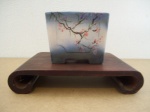
BigDave- Member
 Re: After 20 Years
Re: After 20 Years
Thank you to Jim, Smithy, Sam, John and Marty for reading, and for posting your supportive comments.
Big Dave, I am glad you found the story of my start in bonsai to be encouraging as you begin your own curatorial adventure. Thank you for including the link to the site showing the trees in your collection. I went there and looked at them, and although I recognize the work that is ahead for you, I think your trees are not so bad to begin with. The pictures I have posted below show 3 of the trees I started with, first as they appeared in 1993 (these are the same images I brought with me to Washington to show Bob and Dan), and then a current shot to show how they have developed. A little time with proper care can make a world of difference!
The first is a Cork Bark Chinese Elm (Ulmus parvifolia 'Cork Bark'):
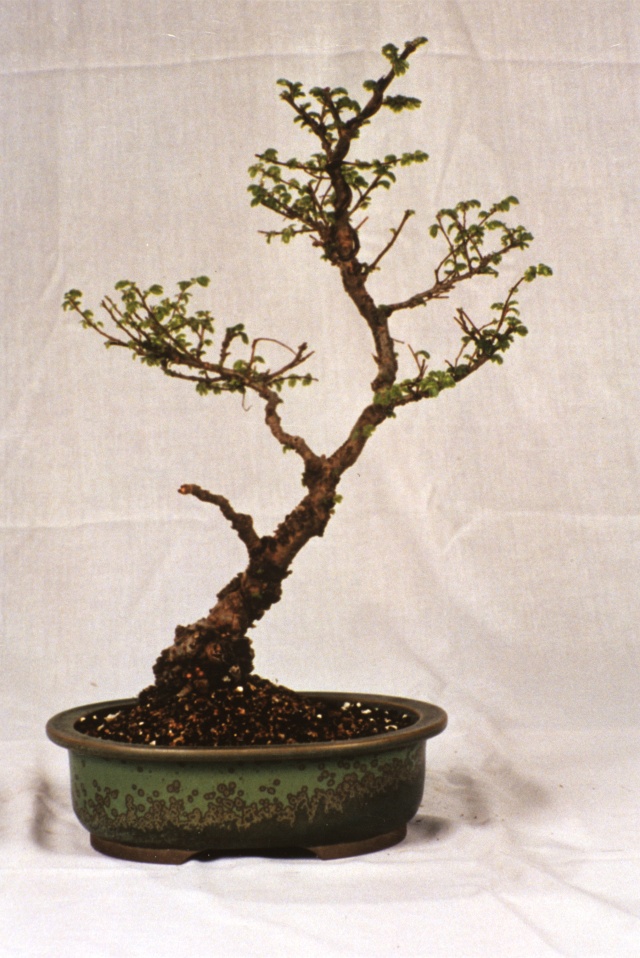

Next, a Procumbens Juniper (Juniperus procumbens 'Nana'):
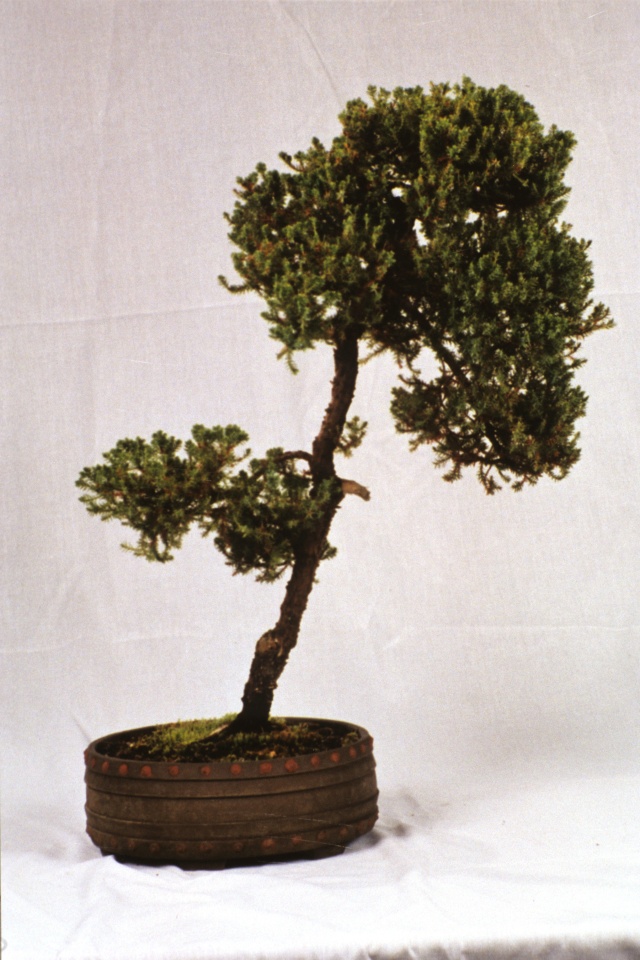

Finally, a Texas Ebony (Ebenopsis ebano):
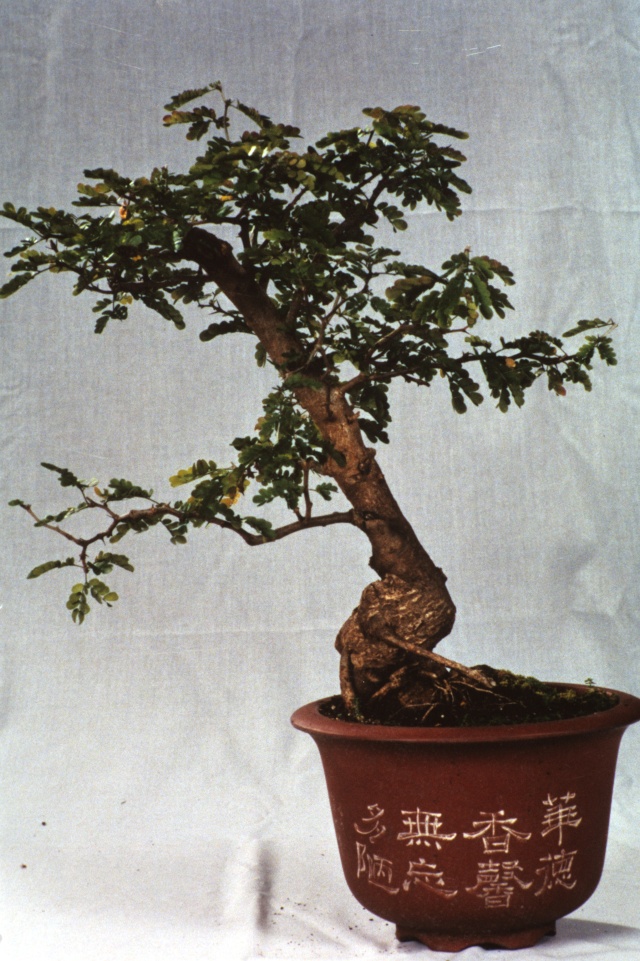
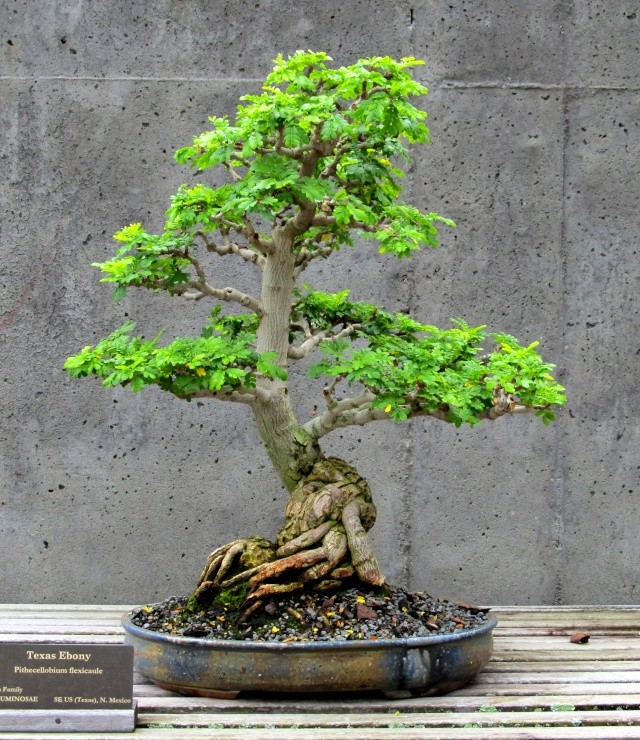
Big Dave, I am glad you found the story of my start in bonsai to be encouraging as you begin your own curatorial adventure. Thank you for including the link to the site showing the trees in your collection. I went there and looked at them, and although I recognize the work that is ahead for you, I think your trees are not so bad to begin with. The pictures I have posted below show 3 of the trees I started with, first as they appeared in 1993 (these are the same images I brought with me to Washington to show Bob and Dan), and then a current shot to show how they have developed. A little time with proper care can make a world of difference!
The first is a Cork Bark Chinese Elm (Ulmus parvifolia 'Cork Bark'):


Next, a Procumbens Juniper (Juniperus procumbens 'Nana'):


Finally, a Texas Ebony (Ebenopsis ebano):



Arthur Joura- Member
 Re: American Bonsai at the NC Arboretum
Re: American Bonsai at the NC Arboretum
Arthur Joura wrote:
Big Dave, I am glad you found the story of my start in bonsai to be encouraging as you begin your own curatorial adventure. Thank you for including the link to the site showing the trees in your collection.
Thanks Arthur,
Most kind to look at the trees, and thanks again for the before and afters photos.
I am encouraged ! By putting together a team and plan, several new better pots, the most needy have been repotted,
we are on our way.
This is a good thing, maybe a new bonsai display is coming...
http://japandailypress.com/3m-pledged-by-kyoceras-inamori-to-san-diegos-japan-friendship-garden-0926623

BigDave- Member
 Random Images From the Ongoing Bedlam of Spring
Random Images From the Ongoing Bedlam of Spring
Last Saturday we celebrated World Bonsai Day here at the NC Arboretum, with the help of Felix Laughlin of the World Bonsai Friendship Federation. Felix delivered an image show while speaking about Saburo Kato and the origin and purpose of World Bonsai Day, and I did a demonstration using a nice Dawn Redwood (Metasequoia glyptostroboides) that Felix donated for the occasion. We limited the program to NC Arboretum members, and still drew a good crowd of more than 80 people:

We have a 100' long hoop house where we keep bonsai that are not on display at the Bonsai Exhibition Garden. In the winter the structure is covered with white poly to protect the plants from weather extremes, and in the spring I gradually reintroduce the sunlight by cutting circular holes in the plastic. This goes on for several weeks as I cut more an more holes to allow more and more sunlight to enter. Eventually we have a bonsai holey house, and it looks like this:
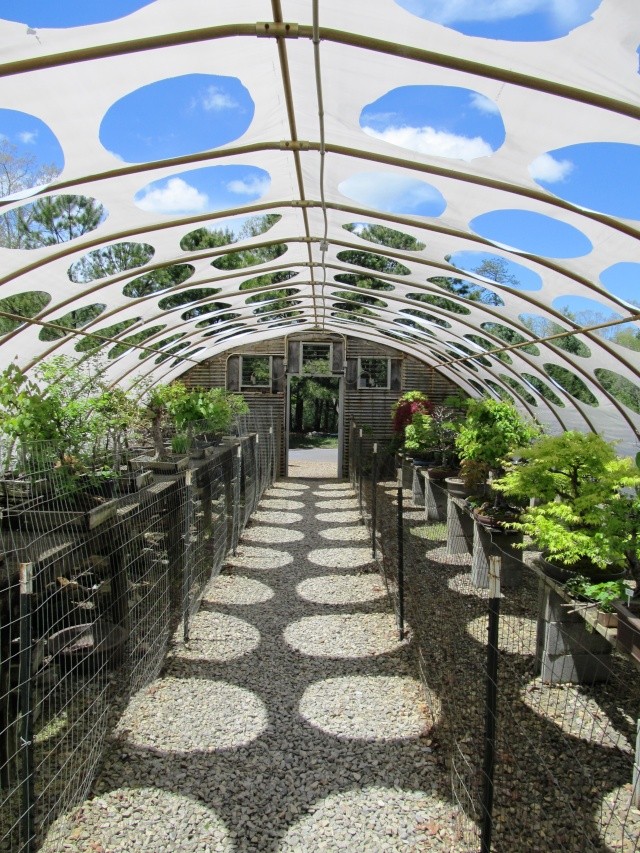
At this riotous time of year the Bonsai Exhibition Garden changes its look just about every week:

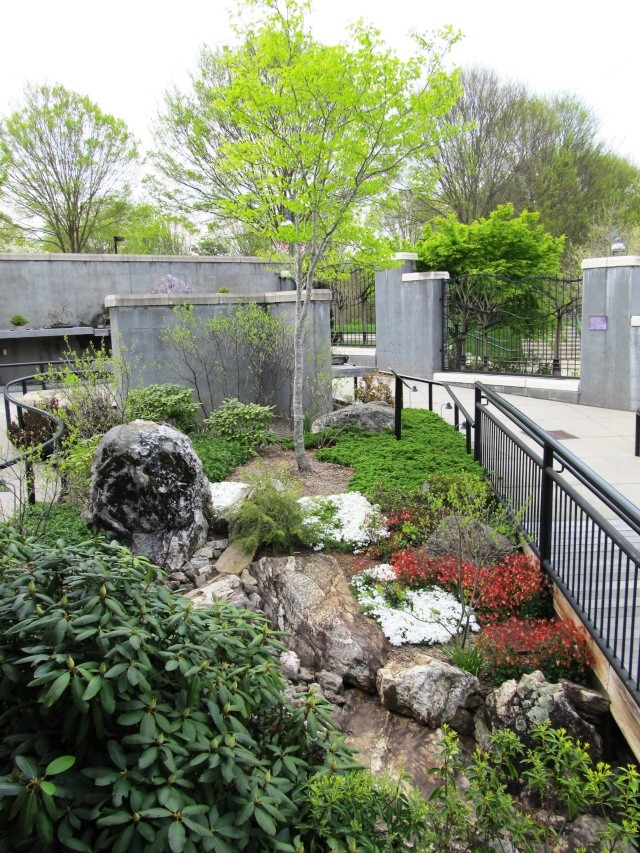
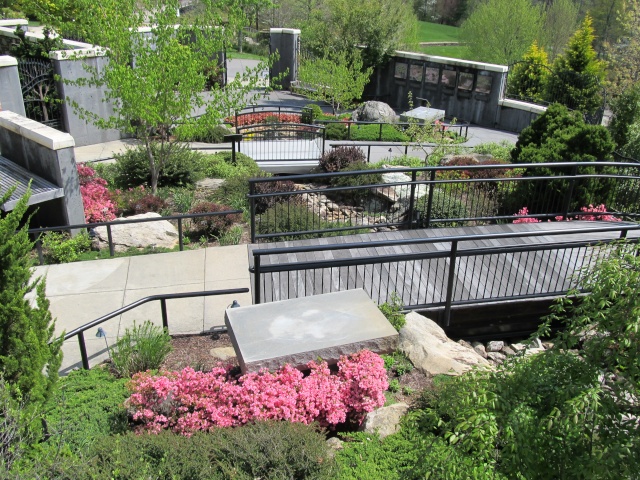
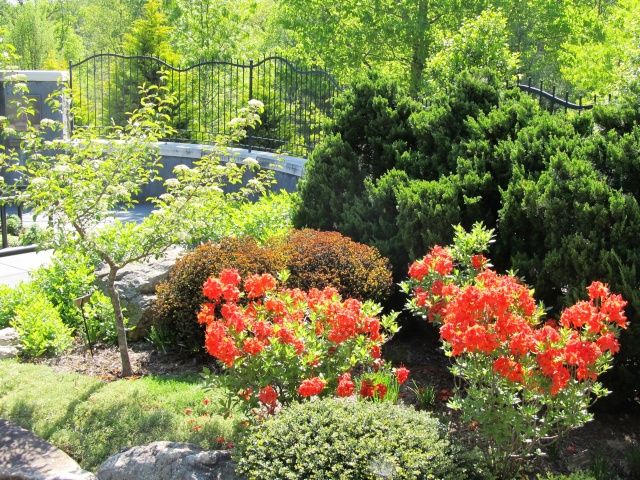
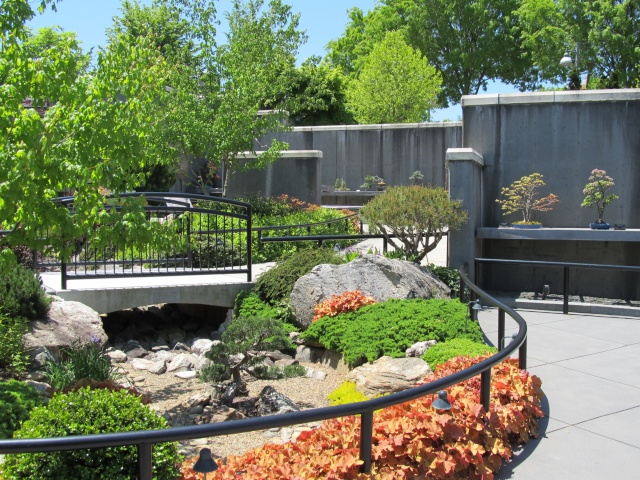
The bonsai have been gradually reappearing on the display benches, although we still do not have all the spaces filled. What follows are a few images of specimens currently on display.
Cut-leaf Japanese Maple (Acer palmatum v. dissectum atropurpureum):

"Roan Mountain" tray landscape, featuring Shimpaku Juniper (Juniperus chinensis 'Shimpaku') and Zakura Azalea (Rhododendron kiusianum 'Zakura'):
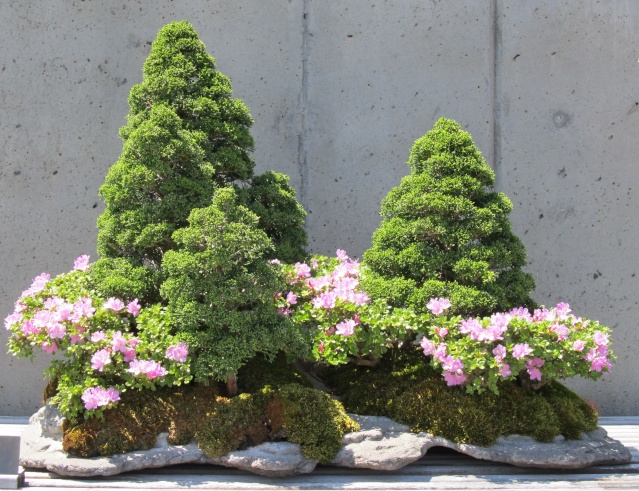
Lilly of the Valley (Convallaria majalis):

Yellowroot (Xanthorhiza simplicissima) and Creeping Bluet (Hedyotis michauxii):
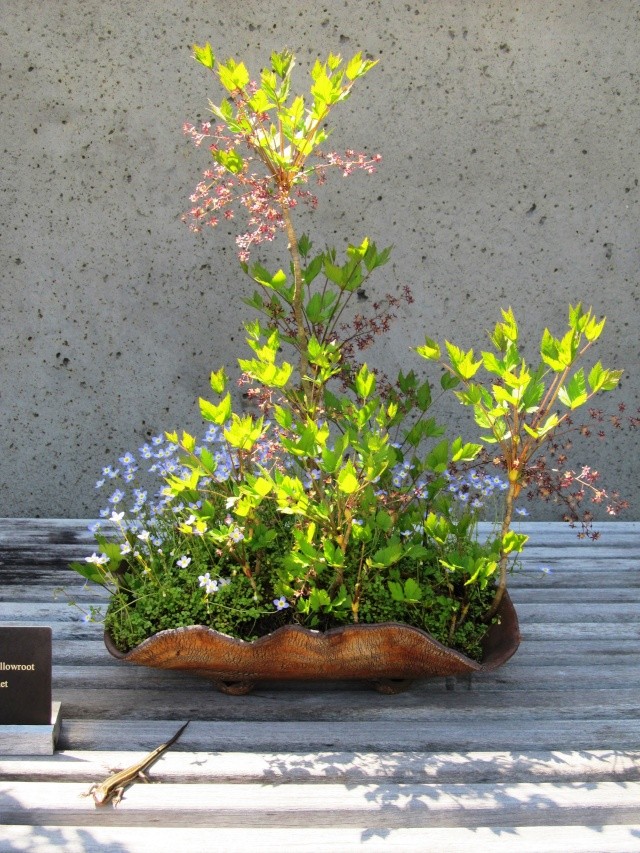
Japanese White Pine (Pinus parviflora):

"Appalachian Cove" tray landscape, featuring 5 different species native to the Southern Appalachian Mountains, with Red Maple (Acer rubrum) providing the much of the color and American Hornbeam (Carpinus caroliniana) being the one with the large, hollowed out trunk:

And finally, because we go to great lengths to avoid using pesticides in the Bonsai Exhibition Garden, it is a place teeming with all sorts of life. The 3 pictures that follow I think of as "the birds & the bees (& the skinks)".
A Chipping Sparrow at the water feature:
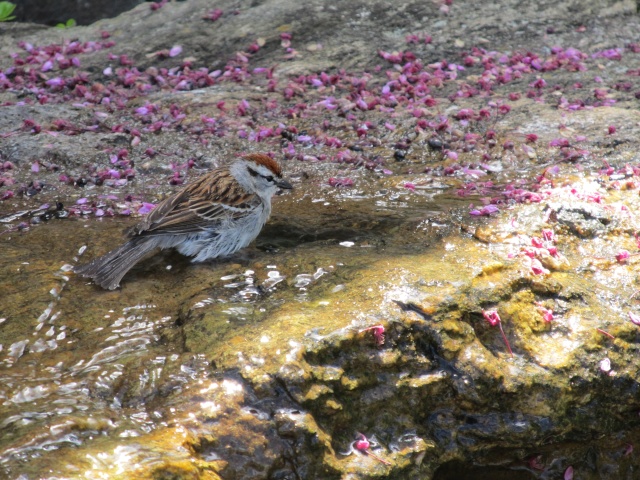
Bumblebees working the Crossvine (Bignonia capreolata):
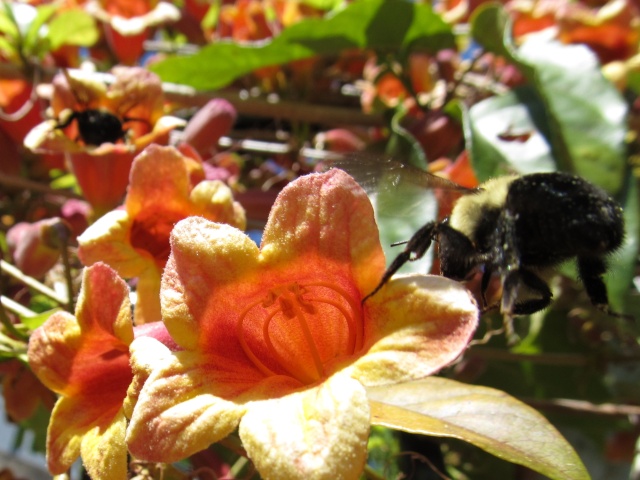
And a couple of Broadhead Skinks, "wrestling" in the dry stream:


We have a 100' long hoop house where we keep bonsai that are not on display at the Bonsai Exhibition Garden. In the winter the structure is covered with white poly to protect the plants from weather extremes, and in the spring I gradually reintroduce the sunlight by cutting circular holes in the plastic. This goes on for several weeks as I cut more an more holes to allow more and more sunlight to enter. Eventually we have a bonsai holey house, and it looks like this:

At this riotous time of year the Bonsai Exhibition Garden changes its look just about every week:





The bonsai have been gradually reappearing on the display benches, although we still do not have all the spaces filled. What follows are a few images of specimens currently on display.
Cut-leaf Japanese Maple (Acer palmatum v. dissectum atropurpureum):

"Roan Mountain" tray landscape, featuring Shimpaku Juniper (Juniperus chinensis 'Shimpaku') and Zakura Azalea (Rhododendron kiusianum 'Zakura'):

Lilly of the Valley (Convallaria majalis):

Yellowroot (Xanthorhiza simplicissima) and Creeping Bluet (Hedyotis michauxii):

Japanese White Pine (Pinus parviflora):

"Appalachian Cove" tray landscape, featuring 5 different species native to the Southern Appalachian Mountains, with Red Maple (Acer rubrum) providing the much of the color and American Hornbeam (Carpinus caroliniana) being the one with the large, hollowed out trunk:

And finally, because we go to great lengths to avoid using pesticides in the Bonsai Exhibition Garden, it is a place teeming with all sorts of life. The 3 pictures that follow I think of as "the birds & the bees (& the skinks)".
A Chipping Sparrow at the water feature:

Bumblebees working the Crossvine (Bignonia capreolata):

And a couple of Broadhead Skinks, "wrestling" in the dry stream:


Arthur Joura- Member
 Whose Art Is It Anyway?
Whose Art Is It Anyway?
A tray landscape originally designed by bonsai great Yuji Yoshimura is currently commanding a great deal of attention in the Bonsai Exhibition Garden, because it looks like this:

The public loves flowers! The blooming "tree" in this planting is one of the Kurume hybrids, named 'Christmas Cheer' (Rhododendron X 'Christmas Cheer'). Most of the rest of the shrubs are Kingsville Dwarf Boxwood (Buxus microphylla v. compacta), with the exception of the largest shrub on the right side of the planting. That one is another azalea, although the variety is unknown. It blooms after the 'Christmas Cheer' azalea is finished and has large pink flowers which somehow do not work at all in the context of this landscape, so its buds are clipped off each year to prevent it from flowering. Although the prime time for this tray landscape is when it is in bloom, it looks good all through the year thanks to a nicely conceived design. The white gravel in the middle of the arrangement suggests water while the rocks delineate the edges of land masses on either side. This is one of several pieces in our collection that has a poetic name, this one being known as "River of Dreams".
I started out by attributing this tray landscape to Mr. Yoshimura, which is technically correct as it was he who first put it together in a demonstration sometime in the 1980's. It was part of a program he did for the Triangle Bonsai Society in the Raleigh, NC area, just one of the countless such presentations he made during the 30-some-odd years he traveled all over the United States and elsewhere in the world educating the public about the art of bonsai. At the end of his demonstration the piece looked like this:

What a difference time makes! Only, it takes more than simply the passage of time; it takes time plus skillful care, persistently applied. Mr. Yoshimura worked on this piece only once, and that was during his demonstration, which we might assume to have been a couple or 3 hours in duration. Fortunately for this piece it went home with a man named Howard Kazan. The late Mr. Kazan was a long time member of the Triangle group and a semi-professional bonsai artist, and later became an avid supporter of bonsai at the NC Arboretum. Mr. Kazan donated this tray landscape to our collection sometime in the very early 2000's. This photograph was taken not long after the piece was given to us:

Obviously, a great deal of change occurred between the time when Mr. Yoshimura created the landscape and when Mr. Kazan donated it to the Arboretum. Some of this difference is a direct result of the plants having had a couple of decades to grow and mature, but there are other differences beyond that. You will notice in the original image there is a variegated plant on the left side of the planting that is no longer there in the later image. Several other plants also appear to be missing, or moved. Mr. Kazan informed me that the azalea originally used on the right side of the landscape died some time shortly after the piece was put together, and he replaced it with another he had on hand (the one with the large pink flowers.) Also, the configuration of the land masses is different. The stones may have been rearranged or the position of what is viewed as the front of the composition might have been rotated slightly clockwise in the container, but somehow the configuration has been changed. Let us also contemplate that part about "the plants having had a couple of decades to grow and mature". During the 20-something years they were doing that, who was holding the scissors? Whose mind made the choices about where to cut and what to remove?
The original image represents what was accomplished by Mr. Yoshimura during a 2 or 3-hour demonstration. The next image represents what Mr. Kazan accomplished over the course of more than 2 decades, working off the starting point of Mr. Yoshimura's original design.
So, is this tray landscape a Yoshimura piece, or a Kazan piece?
Before you answer that question, consider the changes that have taken place in the look of the landscape over the 10 plus-years since Mr. Kazan donated the piece to the Arboretum. For starters, it is in a different container now (the original container cracked.) The position of the stones on the right side is slightly different, too. Plus, all the plants are larger, fuller and different in feeling due to the way they are pruned. I think Mr. Kazan, if he was alive today and could see the piece, would say that everything needs a good thinning out. You might think that, too, and you may be right. If and when the time comes that the plants in the "River of Dreams" tray landscape get strongly headed back, I will be the one holding the scissors. Mr. Yoshimura might be looking over my left shoulder while I work and Mr. Kazan might be looking over my right, but neither one of them will have much say in the matter. I will make the cuts where I think they should be made. In the end, I will make the piece look the way I think it looks best, just as Mr. Kazan did, and just as Mr. Yoshimura did before him.
This is all as it should be, because this is bonsai.
When a painter puts the last stroke of the brush to the canvas, very rarely does anyone follow behind and paint over the work. The same is true for a work of sculpture, or a piece of writing. So when we say, "This is an O'Keeffe painting" or "This is a Calder mobile" or "This is a Hemingway novel", we are talking about a piece of work done by a single person. They may well have been influenced by others, but the finished piece is their original work and it stays the way they made it.
In bonsai, because the medium is alive and growing, constantly changing, it is not possible for the work of any one person to remain intact over any great length of time. The person who has a John Naka tree, for example, can in fact only have a tree that was once shaped by him. Even if Mr. Naka had the tree for 30 years and the person who has it now is keeping it strictly to the same design that Mr. Naka gave it, the tree is invariably changing. It has to. Every time we take scissors to plant we make choices, and these choices reflect our own mind and no one else's. So, what about the person who buys a tree from, say, Walter Pall, and then every year hires Mr. Pall to come and trim the tree and repot it and give advice as to how it should be handled - is that not a Walter Pall tree? Perhaps... for the time being. But it will someday have to be shaped by somebody other than him, unless it dies first... or he lives forever.
In bonsai, every piece that has been around for any substantial length of time has been influenced by each and every person who has grown it. Bonsai is a collaborative art form, not only in the sense that multiple people can and do influence any given piece, but also in the sense that the living plant material contributes its own individual nature, as well. Mmmm, interspecies art... That is an interesting topic in its own right, but it will have to wait for another day.

The public loves flowers! The blooming "tree" in this planting is one of the Kurume hybrids, named 'Christmas Cheer' (Rhododendron X 'Christmas Cheer'). Most of the rest of the shrubs are Kingsville Dwarf Boxwood (Buxus microphylla v. compacta), with the exception of the largest shrub on the right side of the planting. That one is another azalea, although the variety is unknown. It blooms after the 'Christmas Cheer' azalea is finished and has large pink flowers which somehow do not work at all in the context of this landscape, so its buds are clipped off each year to prevent it from flowering. Although the prime time for this tray landscape is when it is in bloom, it looks good all through the year thanks to a nicely conceived design. The white gravel in the middle of the arrangement suggests water while the rocks delineate the edges of land masses on either side. This is one of several pieces in our collection that has a poetic name, this one being known as "River of Dreams".
I started out by attributing this tray landscape to Mr. Yoshimura, which is technically correct as it was he who first put it together in a demonstration sometime in the 1980's. It was part of a program he did for the Triangle Bonsai Society in the Raleigh, NC area, just one of the countless such presentations he made during the 30-some-odd years he traveled all over the United States and elsewhere in the world educating the public about the art of bonsai. At the end of his demonstration the piece looked like this:

What a difference time makes! Only, it takes more than simply the passage of time; it takes time plus skillful care, persistently applied. Mr. Yoshimura worked on this piece only once, and that was during his demonstration, which we might assume to have been a couple or 3 hours in duration. Fortunately for this piece it went home with a man named Howard Kazan. The late Mr. Kazan was a long time member of the Triangle group and a semi-professional bonsai artist, and later became an avid supporter of bonsai at the NC Arboretum. Mr. Kazan donated this tray landscape to our collection sometime in the very early 2000's. This photograph was taken not long after the piece was given to us:

Obviously, a great deal of change occurred between the time when Mr. Yoshimura created the landscape and when Mr. Kazan donated it to the Arboretum. Some of this difference is a direct result of the plants having had a couple of decades to grow and mature, but there are other differences beyond that. You will notice in the original image there is a variegated plant on the left side of the planting that is no longer there in the later image. Several other plants also appear to be missing, or moved. Mr. Kazan informed me that the azalea originally used on the right side of the landscape died some time shortly after the piece was put together, and he replaced it with another he had on hand (the one with the large pink flowers.) Also, the configuration of the land masses is different. The stones may have been rearranged or the position of what is viewed as the front of the composition might have been rotated slightly clockwise in the container, but somehow the configuration has been changed. Let us also contemplate that part about "the plants having had a couple of decades to grow and mature". During the 20-something years they were doing that, who was holding the scissors? Whose mind made the choices about where to cut and what to remove?
The original image represents what was accomplished by Mr. Yoshimura during a 2 or 3-hour demonstration. The next image represents what Mr. Kazan accomplished over the course of more than 2 decades, working off the starting point of Mr. Yoshimura's original design.
So, is this tray landscape a Yoshimura piece, or a Kazan piece?
Before you answer that question, consider the changes that have taken place in the look of the landscape over the 10 plus-years since Mr. Kazan donated the piece to the Arboretum. For starters, it is in a different container now (the original container cracked.) The position of the stones on the right side is slightly different, too. Plus, all the plants are larger, fuller and different in feeling due to the way they are pruned. I think Mr. Kazan, if he was alive today and could see the piece, would say that everything needs a good thinning out. You might think that, too, and you may be right. If and when the time comes that the plants in the "River of Dreams" tray landscape get strongly headed back, I will be the one holding the scissors. Mr. Yoshimura might be looking over my left shoulder while I work and Mr. Kazan might be looking over my right, but neither one of them will have much say in the matter. I will make the cuts where I think they should be made. In the end, I will make the piece look the way I think it looks best, just as Mr. Kazan did, and just as Mr. Yoshimura did before him.
This is all as it should be, because this is bonsai.
When a painter puts the last stroke of the brush to the canvas, very rarely does anyone follow behind and paint over the work. The same is true for a work of sculpture, or a piece of writing. So when we say, "This is an O'Keeffe painting" or "This is a Calder mobile" or "This is a Hemingway novel", we are talking about a piece of work done by a single person. They may well have been influenced by others, but the finished piece is their original work and it stays the way they made it.
In bonsai, because the medium is alive and growing, constantly changing, it is not possible for the work of any one person to remain intact over any great length of time. The person who has a John Naka tree, for example, can in fact only have a tree that was once shaped by him. Even if Mr. Naka had the tree for 30 years and the person who has it now is keeping it strictly to the same design that Mr. Naka gave it, the tree is invariably changing. It has to. Every time we take scissors to plant we make choices, and these choices reflect our own mind and no one else's. So, what about the person who buys a tree from, say, Walter Pall, and then every year hires Mr. Pall to come and trim the tree and repot it and give advice as to how it should be handled - is that not a Walter Pall tree? Perhaps... for the time being. But it will someday have to be shaped by somebody other than him, unless it dies first... or he lives forever.
In bonsai, every piece that has been around for any substantial length of time has been influenced by each and every person who has grown it. Bonsai is a collaborative art form, not only in the sense that multiple people can and do influence any given piece, but also in the sense that the living plant material contributes its own individual nature, as well. Mmmm, interspecies art... That is an interesting topic in its own right, but it will have to wait for another day.

Arthur Joura- Member
 Re: American Bonsai at the NC Arboretum
Re: American Bonsai at the NC Arboretum
Arthur,
Thank you for the additional background information on this planting. It is one of my favorites, but I only knew it as a Howard Kazan planting and did not know anything concerning Yuji Yoshimura's initial design work on it. I thought I knew a lot about the plants in the NC Arboretum due to your posts here, discussions we have had at the Carolinas Bonsai Expos as well as the yearly presentations you have made before the Bonsai Society of the Carolinas. Clearly, as your post above indicates, there are levels of knowledge, involvement and understanding of the histories of these trees we love and cherish that when understood deepens our appreciation of them. Clearly, more exposition is needed on your part!
Regards,
Martin
Thank you for the additional background information on this planting. It is one of my favorites, but I only knew it as a Howard Kazan planting and did not know anything concerning Yuji Yoshimura's initial design work on it. I thought I knew a lot about the plants in the NC Arboretum due to your posts here, discussions we have had at the Carolinas Bonsai Expos as well as the yearly presentations you have made before the Bonsai Society of the Carolinas. Clearly, as your post above indicates, there are levels of knowledge, involvement and understanding of the histories of these trees we love and cherish that when understood deepens our appreciation of them. Clearly, more exposition is needed on your part!
Regards,
Martin
MartinSweeney- Member
 Eye of the Beholder
Eye of the Beholder
Thank you Martin!
The other day I was watering in the Bonsai Exhibition Garden when an older couple came along and engaged me in a conversation. Before long the woman asked something I frequently hear - "Which one is your favorite?" Because I think of that question as frivolous, little more than a pleasant attempt to express interest, I responded in a casual way - "Right now, my favorite is this one here". I nodded towards the bonsai I happened to be watering at the time. The couple looked, and when the woman read the label next to the plant she said, "Oh my goodness, I didn't know you could make a bonsai out of that - we kill that plant in our yard!" The man, silent to this point, grunted, "Is that a bonsai? Doesn't look very old to me..."
The bonsai we were looking at was this Virginia Creeper (Parthenocissus quinquefolia):
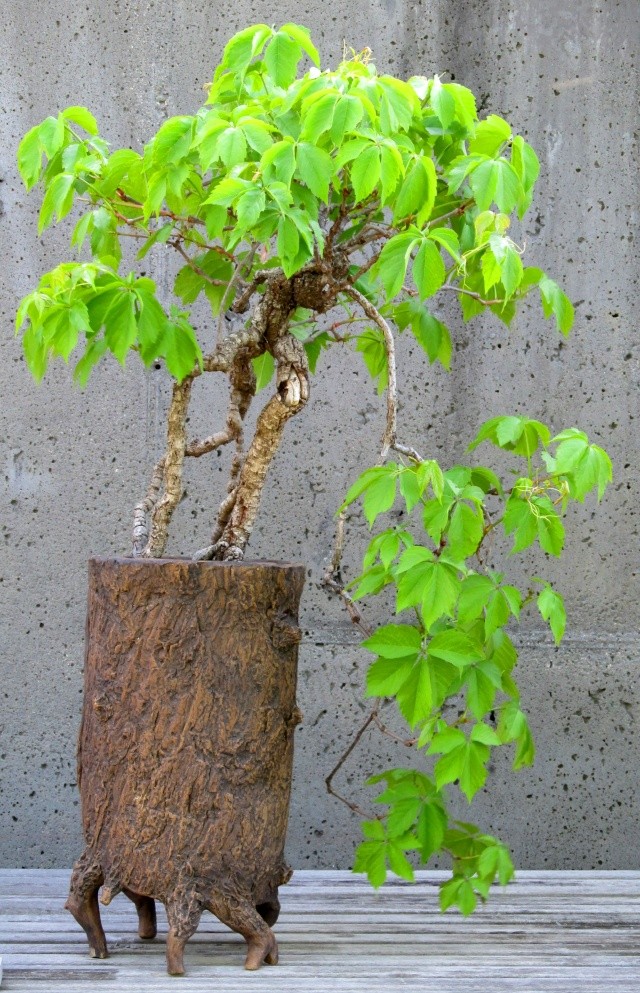
Virginia Creeper is a common vine in this part of the world, sometimes mistaken for Poison Ivy (Toxicodendron radicans) and usually regarded as a weed, which is why many people respond to it with a hoe or a dose of herbicide. While it is a vigorous grower that will freely volunteer to grow in a wide range of sites and conditions, it is a plant native to this region and not without attributes: it requires little or no care; it will grow in full sun or partial shade and is highly drought-tolerant; it can be pruned as much as you might like; its flowers are extremely attractive to a variety of bees; it has outstanding, deep red autumn color; and its blue fruits are a valuable wildlife food. In the right location, Virginia Creeper can be quite ornamental and used to good landscape effect. We have it in the bonsai garden, crawling up a rounded stone wall near the water feature (here seen in its autumn color phase, on the upper left):

Our Virginia Creeper bonsai came from my home landscape, where it had volunteered in an old abandoned raised garden bed. This bed had been built by the previous occupant of my house many years earlier and was already in dilapidated condition by the time my family and I moved into the place. The walls of the raised bed were 3 feet high and made of untreated pine. Over time the pine rotted and fell away, leaving a mound of earth that gradually eroded with years of rain. The roots of the Virginia Creeper were exposed as the soil line receded, and one day I looked at it and thought it might make an interesting exposed root, cascade form bonsai. I collected it one spring and planted it in a plastic pot. The next spring I moved it into a bonsai container and it was on display in the garden later that year. There are advantages to working with a tough, fast growing species!
The container currently employed for this bonsai is not the same one I originally used. A few years ago a friend from the Hinoki Bonsai Club in Roanoke, VA donated the unique container in question, saying she had purchased it from Dave Lowman at DaSu Bonsai Studios in Iowa, and never could figure out what to plant in it. I did not know what would work with it either, but one day it occurred to me that the Virginia Creeper might be the perfect choice - an unusual plant for an unusual container. Sometimes when I look at them in combination I think of the image as being that of an Ent, the anthropomorphic trees from the "Lord of the Rings". The legs on the container give the impression that this bonsai might walk away at any moment.
Here is a sequence showing the seasonal interest of this specimen, plus a closeup of the fruit:
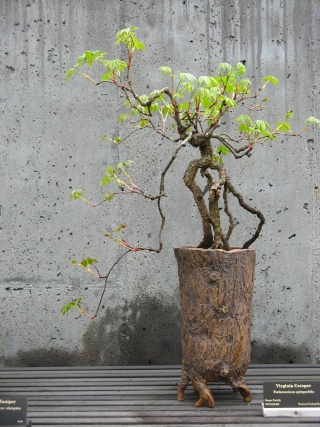

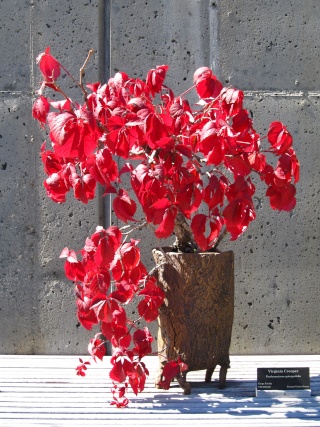
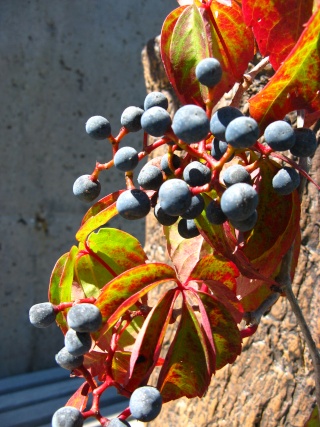
You may notice that I chose to lower the top of the bonsai this year, producing a more umbrella-like look to the upper line of the cascade:


This decision was inspired by a wild plant I am familiar with in the mountains nearby. In this case, the plant actually is Poison Ivy, and it is a root-over-rock rather than exposed root form:
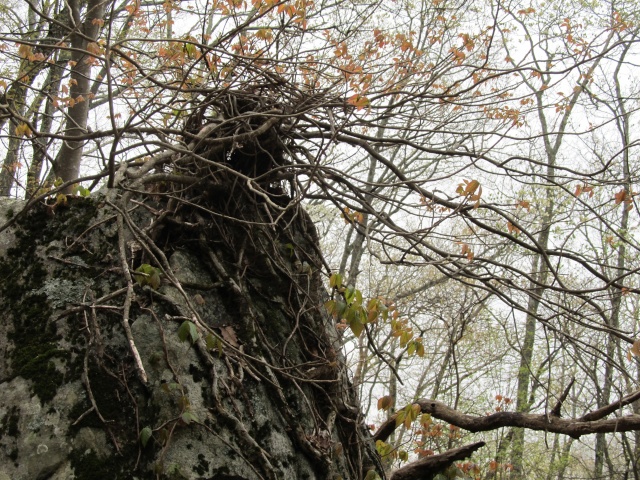
It is difficult to get a sense of scale from an image such as this. The spread of this plant, if measured side to side would be over 8 feet in length. The boulder it is growing on could easily crush a car.
--
The other day I was watering in the Bonsai Exhibition Garden when an older couple came along and engaged me in a conversation. Before long the woman asked something I frequently hear - "Which one is your favorite?" Because I think of that question as frivolous, little more than a pleasant attempt to express interest, I responded in a casual way - "Right now, my favorite is this one here". I nodded towards the bonsai I happened to be watering at the time. The couple looked, and when the woman read the label next to the plant she said, "Oh my goodness, I didn't know you could make a bonsai out of that - we kill that plant in our yard!" The man, silent to this point, grunted, "Is that a bonsai? Doesn't look very old to me..."
The bonsai we were looking at was this Virginia Creeper (Parthenocissus quinquefolia):

Virginia Creeper is a common vine in this part of the world, sometimes mistaken for Poison Ivy (Toxicodendron radicans) and usually regarded as a weed, which is why many people respond to it with a hoe or a dose of herbicide. While it is a vigorous grower that will freely volunteer to grow in a wide range of sites and conditions, it is a plant native to this region and not without attributes: it requires little or no care; it will grow in full sun or partial shade and is highly drought-tolerant; it can be pruned as much as you might like; its flowers are extremely attractive to a variety of bees; it has outstanding, deep red autumn color; and its blue fruits are a valuable wildlife food. In the right location, Virginia Creeper can be quite ornamental and used to good landscape effect. We have it in the bonsai garden, crawling up a rounded stone wall near the water feature (here seen in its autumn color phase, on the upper left):

Our Virginia Creeper bonsai came from my home landscape, where it had volunteered in an old abandoned raised garden bed. This bed had been built by the previous occupant of my house many years earlier and was already in dilapidated condition by the time my family and I moved into the place. The walls of the raised bed were 3 feet high and made of untreated pine. Over time the pine rotted and fell away, leaving a mound of earth that gradually eroded with years of rain. The roots of the Virginia Creeper were exposed as the soil line receded, and one day I looked at it and thought it might make an interesting exposed root, cascade form bonsai. I collected it one spring and planted it in a plastic pot. The next spring I moved it into a bonsai container and it was on display in the garden later that year. There are advantages to working with a tough, fast growing species!
The container currently employed for this bonsai is not the same one I originally used. A few years ago a friend from the Hinoki Bonsai Club in Roanoke, VA donated the unique container in question, saying she had purchased it from Dave Lowman at DaSu Bonsai Studios in Iowa, and never could figure out what to plant in it. I did not know what would work with it either, but one day it occurred to me that the Virginia Creeper might be the perfect choice - an unusual plant for an unusual container. Sometimes when I look at them in combination I think of the image as being that of an Ent, the anthropomorphic trees from the "Lord of the Rings". The legs on the container give the impression that this bonsai might walk away at any moment.
Here is a sequence showing the seasonal interest of this specimen, plus a closeup of the fruit:




You may notice that I chose to lower the top of the bonsai this year, producing a more umbrella-like look to the upper line of the cascade:


This decision was inspired by a wild plant I am familiar with in the mountains nearby. In this case, the plant actually is Poison Ivy, and it is a root-over-rock rather than exposed root form:

It is difficult to get a sense of scale from an image such as this. The spread of this plant, if measured side to side would be over 8 feet in length. The boulder it is growing on could easily crush a car.
--

Arthur Joura- Member
Page 2 of 40 •  1, 2, 3 ... 21 ... 40
1, 2, 3 ... 21 ... 40 
 Similar topics
Similar topics» American Bonsai at the NC Arboretum
» WISTERIA BONSAI AT INTERNATIONAL BONSAI ARBORETUM
» Ashville arboretum bonsai
» Show the Autumncolour from your bonsai
» Trip to the Rochester Arboretum
» WISTERIA BONSAI AT INTERNATIONAL BONSAI ARBORETUM
» Ashville arboretum bonsai
» Show the Autumncolour from your bonsai
» Trip to the Rochester Arboretum
Page 2 of 40
Permissions in this forum:
You cannot reply to topics in this forum











